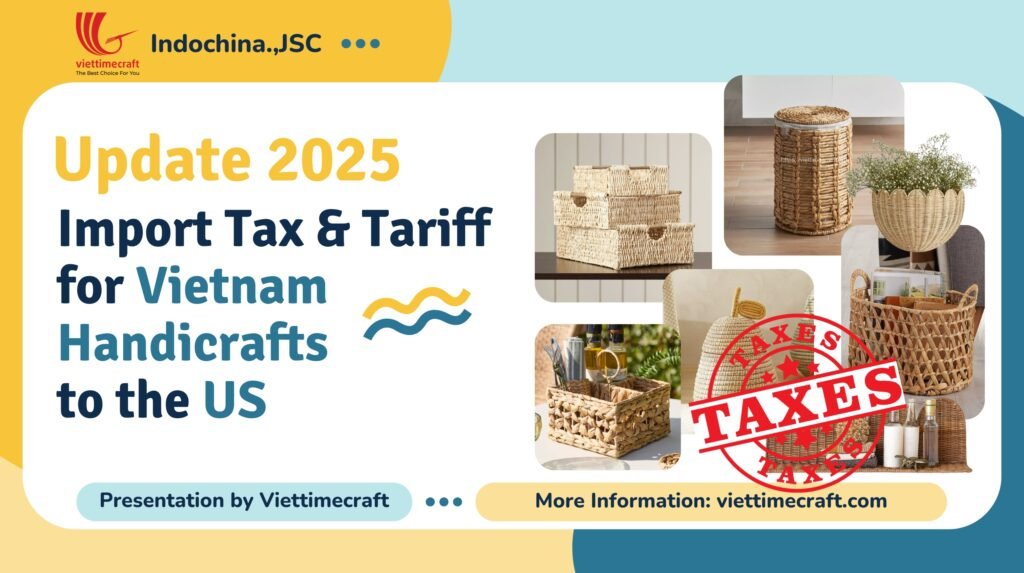About: Update 2025: import tax, hs code lookup, delivered duty paid and us import tariff in handicrafts.
HANOI, April 2025 — Vietnamese exporters of handicrafts are once again watching Washington closely as newly re-elected U.S. President Donald Trump introduces a fresh wave of trade adjustments that could impact customs duties for key product categories—including eco-friendly handmade goods from Southeast Asia.
Although Vietnamese handicrafts continue to enjoy relatively low US import tariff rates under WTO’s Most Favored Nation (MFN) framework, Trump’s 2025 proposal to tighten tariffs on imports from Asia—including Vietnam—is raising eyebrows in the export community.
“The new tariff package isn’t directly targeting Vietnam—yet,” said Nguyen Hoang Minh, a trade compliance analyst in Ho Chi Minh City. “But the language signals a shift in tone toward broader regional control, which could affect bamboo and rattan goods soon.”
I. Popular Handicraft Items Exported to the U.S.
Vietnamese handicrafts made from natural materials are increasingly favored by USA buyers. Some commonly exported items is: storage baskets and boxes, decorative trays and bowls, rattan lamps and bamboo furniture, etc.
Each product line will have a HS code (8 numbers) to look up tariffs. With natural products made from rattan, bamboo, seagrass, water hyacinth, HS code usually starts with 4602.xx.xx. These are usually classified under various HS codes. Example:
These are usually classified under various HS codes. Example:
- 4602.11.00 – Baskets and bags, of vegetable materials.
- 4602.19.60 – Other plaited articles.
- 4601.22.40 – Mats and screens made of plant-based materials.
Performing an accurate HS code lookup is essential before shipping.
What’s in the Trump 2025 Tariff Proposal?
While the Biden administration prioritized multilateral diplomacy and green trade incentives, Trump’s comeback plan puts pressure on U.S. trade deficits and prioritizes domestic manufacturing.
The new trade directive—announced in March 2025—proposes:
- Across-the-board import tax increases of 10–15% on selected non-essential goods.
- A re-evaluation of MFN privileges for “unbalanced trade partners”.
- Stricter customs inspections for plant-based and eco-material goods.
Although Vietnam is not currently on the tariff hike list, categories such as woven baskets, trays, and mats made from natural fibers could face additional scrutiny or longer clearance times.
II. Current Import Tax Policies for US – Bound Handicrafts
1. US Import tax & import Tariff Rates by Product Type
Vietnam’s bamboo, rattan, seagrass, and water hyacinth products are still widely welcomed in the U.S. market, particularly through eco-conscious retailers. Some Vietnamese handicraft products are entitled to policies from MFN (the most popular country), resulting in US import tax rates between 5% – 18%.
Examples:
- Bamboo baskets (HS 4602.11.00): approx. 5-10%.
- Of Rattan (HS 4602.12.60): approx. 5-18%.
- Of palm leaf (HS 4602.19.00): 9-18%.
✅ Note: Always Confirm updated rates on the usitc website: Harmonized Tariff Schedule for the most accurate tax rate.
2. Special Import Tax Privileges or Exemptions
Now, Vietnam is not part of the U.S. GSP program (Generalized System of Preferences).
III. Required Export Documents for U.S. Shipments
Exporters are required to prepare documentation to comply with U.S. customs tariff regulations before shipping goods to the United States. Below are 6 commonly required documents:
- Commercial Invoice.
- Packing List.
- Export Contract.
- Certificate of Origin (Form B).
- Fumigation Certificate.
- Safety or compliance documents if requested by U.S. buyers.

IV. Key Considerations When Working with U.S. Importers
The key to success is thorough and careful preparation, and never underestimating any detail.
- Label products clearly: name, material, origin (“Made in Vietnam”).
- Ensure compliance with U.S. safety standards.
- Remove hazardous substances (lead, formaldehyde, etc.).
- Prepare for pre-shipment inspections or testing if requested.
V. Pro Tips for Exporting Handicrafts Smoothly
- Work with a freight forwarder experienced in U.S. shipments.
- Use trusted tools for HS code lookup and tariff checks.
- Stay updated via Vietnam’s trade offices or customs agents.
- Consider Delivered Duty Paid (DDP) for B2C fulfillment (e.g., Amazon FBA).
Conclusion
Understanding the US import tax, customs customs and appropriate documents are essential to succeed in the US market. While the tariffs are relatively complicated and many fluctuations, compliance standards are strict, careful preparation is the key to success.
Wishing the Vietnamese exporter can thrive in the field of handicrafts of the United States by 2025 and more!

